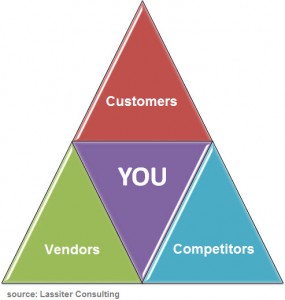When looking for hedge fund jobs, perhaps the most important part of the process is developing a plan. We recently caught up with the author of The New Job Security, Pam Lassiter to talk about this topic (among others). A veteran career advisor, Pam has provided career advice for three decades and has seen many up and down job markets. She offers some practical advice for someone looking for a hedge fund job in this excerpt from the interview.
Job Search Digest: When somebody is looking at making a change what approach do you recommend for them in terms of developing their job search plan?
Pam Lassiter: Okay, a change within industry or outside of industry? You want to stick within industry to start off with?
Job Search Digest: A good differentiation. Yeah, let’s start within the industry.
Pam Lassiter: My referral triangle. Simple answer. If you visualize a triangle in front of you and put yourself in the middle, the fat part of the triangle, there are three ways that people typically leave their firms or their companies, and it’s through the points of the triangle: vendor, competitor, customer. And that goes for venture, private equity, or hedge as well. So let me talk that through for a second.
 Vendors, what’s coming into your firm? You don’t have to touch these people to be of value to them.
Vendors, what’s coming into your firm? You don’t have to touch these people to be of value to them.
Let’s say there’s some software your firm has been buying and it has to do with modeling and you’re interested in software. So that’s a conversation you could be having right there about – people that sell into companies are very well-connected, by the way.
So even if you don’t want to work for their company, they can tell you what venture firms are growing, who isn’t, who’s having trouble, because they’re in there all the time. So not only may you be interested in them as an end, they can become a means to marketplace information too.
Job Search Digest: What a great insight. Because you’re exactly right, those vendors, those salespeople, it’s their job to understand what’s happening in the industry, and more likely than not, they’re going after some of the hotter firms, the emerging firms, and they’re probably going to have contacts in many of those.
Pam Lassiter: They may well. And if they’re good and smart they’ll figure out – if they help you land your next job, you can’t make any guarantees, but you can certainly tell them, “If I land at one of those firms, I’d be delighted to have you in for a conversation.” So you can’t promise anything, but they can see they can help themselves if they help you.
And that’s second of the five strategies I teach about the marketing for mutual benefit, what’s in it for them. You can help point that out to them if they aren’t getting it on their own, and they will know the companies that are hot and the ones that aren’t. There are other vendors, like the law firms and the accounting and tax firms. So think about the vendor side.
The competitor side, it’s interesting. I love the word “should”. If you can see what the competition is doing and your own firm is not doing it, maybe they should be. Maybe their lunch is going to be eaten because they aren’t. So you have a conversation that’s not about you; it’s about the opportunity in the marketplace. So look at competition with other firms as well as is there an area for growth within your own firm. So vendors and competitors.
Now the customer side or private equity, VC, or hedge funds, where does the money come from is the question to ask yourself. And should we be talking – are there institutional investors out there that might be of interest? Are there limited partners, are there acquirers, are there strategic divisions, as in companies that this function could be embedded within?
So thinking more creatively about the client side, where the money is coming from, and are there niches for me within that. Or getting back to should, are there niches that should be developed within some of these strategic areas or some of the – maybe publicly held companies are investing in your hedge fund too.
So maybe there should be some niches around there. Easy flip over often is business development. If you’re a deal-maker on one side, you can be a deal-maker within a company as well. And so you’re just working back with the types of companies or firms or portfolio companies that you’ve come from. Is that making sense?
Job Search Digest: Absolutely. And it’s those translatable skills, those transferable skills, I should say, where you are a deal-maker and it’s a function of them saying, “Here’s where I’ve got that experience and here is where I can translate that into this new niche.” And especially in a case where, like you said, where the investment firm should be operating.
Pam Lassiter: Yeah. Or where you should be, even if your firm isn’t.
About Pam Lassiter
In addition to authoring The New Job Security, Pam Lassiter is the founder of Lassiter Consulting, a firm that offers career management services such as employee retention, career coaching, outplacement and more to companies and individuals worldwide.
Want to learn more? You can listen to the entire Pam Lassiter Interview (to download, right click and “save as”)
You can also pre-order the latest version on The New Job Security (and save 32%)






Comments on this entry are closed.